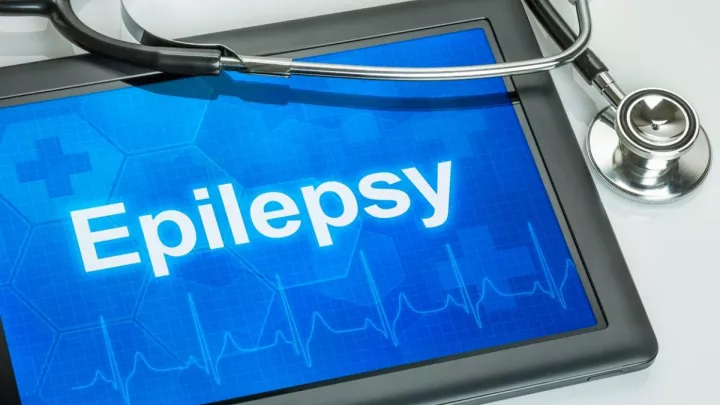How common are childhood seizures, and how do I know if my child has epilepsy?

If your child has been diagnosed with epilepsy, you may be concerned that it will be a lifelong condition. But research shows that’s not the case.
“Up to 80% of children will outgrow epilepsy by age 18,” says Sookyong Koh, MD, PhD, Nebraska Medicine pediatric epileptologist and chief of Neurology at Children’s Hospital and Medical Center.
Epilepsy can develop at any time, but most commonly during childhood. In fact, it is one of the most common neurological disorders among children, occurring in 100 of every 100,000 children.
“It is estimated that 8% to 10% of children will experience a seizure and 2% to 3% will go on to develop epilepsy,” Dr. Koh says. “It is most common during the first year of life and declines in subsequent years.”
Seizures are caused by excessive electrical discharges in a group of hyperexcitable neurons or brain cells. Dr. Koh defines epilepsy as a “disorder of the brain characterized by an enduring predisposition to generate epileptic seizures.” When a child has two or more unprovoked seizures, they are clinically diagnosed with epilepsy.
A variety of factors can cause seizures in children. Often, the cause is unknown. It should be noted that research has not found any evidence linking immunizations to epilepsy. The most common identifiable causes include:
- Fever
- Genetic causes
- Head injury
- Infections of the brain
- Lack of oxygen to the brain
- Excess water in the brain cavities
- Structural malformation or brain development disorders
The most common childhood epilepsies and their symptoms are listed below. Most children will grow out of these types of seizures.
Childhood absence epilepsy – During absence seizures, your child will stare blankly ahead and may blink rapidly or appear to be chewing. Your child may appear to be daydreaming, but they are completely unconscious and cannot respond. It typically lasts just a few seconds, after which your child may seem perfectly normal.
Epilepsy with generalized tonic-clonic seizures – These seizures are associated with a complete loss of consciousness and muscle contractions. Your child may stiffen (tonic), suddenly collapse and fall (atonic or tonic) or jerk rhythmically (clonic). These seizures usually last one to five minutes and are typically followed by extreme fatigue.
Self-limited epilepsy with central temporal spike – These seizures tend to occur out of sleep and affect one side of a child’s body. Your child may have a tingling feeling on one side of their mouth and have difficulty speaking. They may also experience drooling and twitching on one side of their mouth or face that can spread to their arms or legs. These are nocturnal seizures that start when your child falls asleep or before waking up.
What are febrile seizures?
One of the most common causes of infant and childhood seizures is febrile seizures, or those caused by a high fever. These occur in 2% to 5% of all children and may run in families. These are not considered epilepsy. Most children grow out of febrile seizures. However, in rare cases, a child may experience prolonged febrile seizures and then develop recurrent seizures originating from the temporal lobe as an adolescent and adult. This area of the brain controls language, memory and emotions. While temporal lobe epilepsy is a fairly uncommon type of childhood epilepsy, it is one of the most common types of epilepsy that is resistant to medications and requires surgical intervention.
Diagnosis of epilepsy
Your doctor should evaluate any seizure event experienced by your child. “Once your child has experienced one seizure, they have a 25% to 50% chance of experiencing a second seizure,” notes Dr. Koh. “After two seizures, that risk increases to 75%.”
There are many different types of seizures. Therefore, it is important to carefully watch what happens to your child during a seizure so you can provide an accurate description to your doctor to help with identifying the type.
Diagnosis is made based on clinical evaluation, an electroencephalogram, or EEG, (a test that measures electrical activity in the brain), magnetic resonance imaging, or MRI, and genetic testing. “EEG, brain MRI and genetic tests are very important. They can help us determine if your child has epilepsy, what type of epilepsy and why, and the prognosis – whether your child is likely to outgrow their epilepsy or whether they will have drug-resistant epilepsy,” says Dr. Koh.
Treatment for epilepsy
“Approximately 60% to 80% of childhood epilepsies will achieve complete remission,” says Dr. Koh. Many will respond to seizure-preventing drugs. Other treatments include resective surgery, which removes a small part of the brain where the seizures originate, a ketogenic diet or neuromodulation. Neuromodulation involves altering nerve activity through the targeted delivery of a stimulus, such as electrical stimulation.
Epilepsy caused by genetic alterations, and structural or developmental issues of the brain comprise approximately 25% of childhood epilepsies. These types are often the most difficult to treat.
“Getting early diagnosis and treatment for childhood epilepsy is very important as repeated or prolonged seizures can result in injury to the brain, changes in the brain and can interfere with development during a critical period of growth,” says Dr. Koh. “The sooner we begin treatment, the better the outcomes.”







